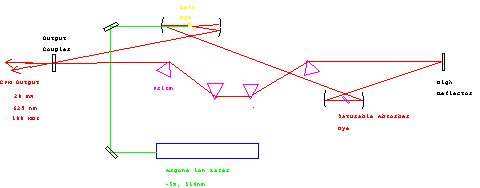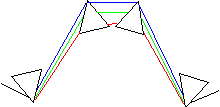Ultrafast THZ Optoelectronic Laboratory
The Colliding Pulse Mode-Locked Dye Laser
-
One home built CPM dye laser generating ultrashort pulses with pulse durations as short as 60 fs.
The Colliding Pulse Mode locked Dye Laser- or CPM- was the first laser capable of generating ultrashort pulses of less than 100 fs duration. The CPM laser was developed in 1980 by Fork, Greene, and Shank at Bell Labs (Applied Physics Letters, vol. 38, p. 671, 1981). An improved version of the CPM laser, utilizing prisms for dispersion compensation, was built in 1985 by Valdmanis, Fork, and Gordon (Optics Letters, vol. 3, p. 131, 1985; IEEE Journal of Quantum Electronics, vol. 22, p. 112, 1986) producing pulsewidths as short as 27 fs.
The CPM is a passively mode-locked ring cavity dye laser pumped by a cw Ar+ laser. The ring cavity of the laser permits two counter-propagating pulses to exist in the cavity simultaneously. Since the mode-locking process is passive, the CPM is relatively insensitive to thermal and mechanical perturbations. The pulse train in the CPM cavity builds up from noise fluctuations on an initially cw photon flux within the cavity. Mode locking occurs due to a saturable absorber dye jet within the cavity which provides an intensity dependent loss. The counter-propagating pulse trains collide in the absorber jet since maximal absorber bleaching occurs when both pulses are coincident. The laser cavity geometry is designed so that the pulses will be as far apart as possible when either passes through the gain jet to permit maximum recovery of the gain medium and thus maximum gain. It also allows the counter-propagating pulse trains to be amplified equally. A diagram of the CPM laser is shown in the figure below.
There are four main pulse shaping mechanisms that lead to ultrashort (sub 100 fs) duration pulses. These are gain saturation, absorber saturation, self phase modulation, and group velocity dispersion. Obtaining reliable sub 100 fs pulses involves balancing these four processes (see Martinez, et. al., Optics Letters, vol. 9, p. 156, 1984). Although only a general qualitative description of the four processes important in achieving sub 100 femtosecond operation is given here, a detailed description of mode-locking and pulse shaping in the CPM laser can be found in Martinez, et. al., Optics Letters, vol. 9, p. 156, 1984 and H. Haus, IEEE Journal of Quantum Electronics, vol. 11, p. 736, 1975.
Saturation of the gain medium by the intracavity pulse train results in the leading edge of the pulse being amplified more than the trailing edge. A net shift of energy to the leading edge results, causing the pulse to steepen. Gain saturation causes attenuation of the low energy wings of the trailing edge of the pulse after several cavity round trips. In absorber saturation, the leading edge of the pulse is attenuated more strongly in the absorber jet than the trailing edge resulting in a net shift of energy to the trailing edge of the pulse. Again the pulse steepens due to attenuation of the low energy wing of the leading edge.
Self phase modulation (SPM) is a third order nonlinear process caused by an intensity dependent nonlinear index of refraction. Self phase modulation arises from the third order susceptibility term in the expansion of the material polarization. The nonlinear wave equation is derived from Maxwell's Equations using the third order nonlinear polarization as a driving term. The phase is a function of E2(t), the time dependent intensity of the optical pulse envelope traveling though the medium. This time dependent phase results in a frequency modulation, or chirp, of the pulse. A frequency modulation resulting in higher frequencies temporally leading lower frequencies is defined as negative chirp; positive chirp has lower frequencies leading higher frequencies. The frequency modulation of the pulse is responsible for spectral broadening. Self phase modulation does not affect the temporal shape of the pulse envelope. The development of SPM in the CPM cavity comes from two sources. Positive SPM arises from the third order nonlinear susceptibility in the dye solvent. A second source of SPM is the time dependent saturation of the absorber dye. This can provide either positive or negative SPM depending on the relationship between the operating wavelength and the spectral shape of the absorption. The net SPM is expected to be positive. A method of providing negative chirp within the cavity is needed to achieve transform limited pulses from the laser i.e. those with a minimum time-bandwidth product.
Negative chirp is provided by group velocity dispersion (GVD), introduced by the four
intracavity prisms as shown in the figure below. Group velocity dispersion arises
since the group velocity of light decreases with increasing frequency for most materials
in the visible region of the spectrum. This causes the low frequency components of
any pulse envelope to propagate faster than the higher frequency components. The pulse
envelope is temporally broadened and develops a positive chirp. The arrangement of
prisms shown in the figure above permits negative group velocity dispersion to be
achieved using materials with positive GVD. Light is spectrally dispersed by the first
prism. The lower frequency components of the light must travel through more glass
in the second prism and are delayed relative to the high frequency components resulting
in negative chirp. A second pair of prisms is needed to spatially recombine the beam.
The layout of the four prisms shown in the figure above allows the group velocity
dispersion to be adjusted from positive to negative by translating the prisms so that
the beam must travel through less glass.
high frequency (blue)
lower frequency (red)
Intracavity pulse compression is achieved by balancing the positive chirp due to self phase modulation from the interaction of the intracavity beam and the dye jet, and the negative chirp due to GVD from the prisms. This process is also referred to as soliton-like pulse shaping since it is similar to the soliton pulse shaping process that occurs in optical fibers.


